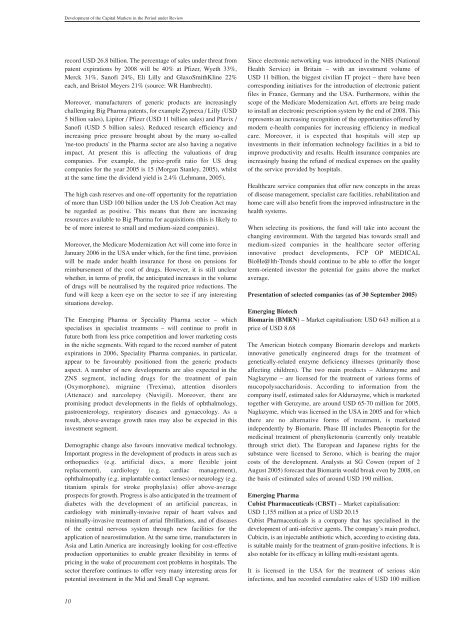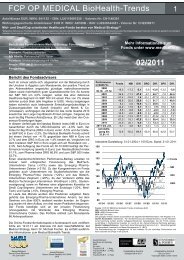FCP OP MEDICAL BioHe@lth-Trends - medical.lu
FCP OP MEDICAL BioHe@lth-Trends - medical.lu
FCP OP MEDICAL BioHe@lth-Trends - medical.lu
Create successful ePaper yourself
Turn your PDF publications into a flip-book with our unique Google optimized e-Paper software.
Development of the Capital Markets in the Period under Review<br />
record USD 26.8 billion. The percentage of sales under threat from<br />
patent expirations by 2008 will be 40% at Pfizer, Wyeth 33%,<br />
Merck 31%, Sanofi 24%, Eli Lilly and GlaxoSmithKline 22%<br />
each, and Bristol Meyers 21% (source: WR Hambrecht).<br />
Moreover, manufacturers of generic products are increasingly<br />
challenging Big Pharma patents, for example Zyprexa / Lilly (USD<br />
5 billion sales), Lipitor / Pfizer (USD 11 billion sales) and Plavix /<br />
Sanofi (USD 5 billion sales). Reduced research efficiency and<br />
increasing price pressure brought about by the many so-called<br />
'me-too products' in the Pharma sector are also having a negative<br />
impact. At present this is affecting the va<strong>lu</strong>ations of drug<br />
companies. For example, the price-profit ratio for US drug<br />
companies for the year 2005 is 15 (Morgan Stanley, 2005), whilst<br />
at the same time the dividend yield is 2.4% (Lehmann, 2005).<br />
The high cash reserves and one-off opportunity for the repatriation<br />
of more than USD 100 billion under the US Job Creation Act may<br />
be regarded as positive. This means that there are increasing<br />
resources available to Big Pharma for acquisitions (this is likely to<br />
be of more interest to small and medium-sized companies).<br />
Moreover, the Medicare Modernization Act will come into force in<br />
January 2006 in the USA under which, for the first time, provision<br />
will be made under health insurance for those on pensions for<br />
reimbursement of the cost of drugs. However, it is still unclear<br />
whether, in terms of profit, the anticipated increases in the vo<strong>lu</strong>me<br />
of drugs will be neutralised by the required price reductions. The<br />
fund will keep a keen eye on the sector to see if any interesting<br />
situations develop.<br />
The Emerging Pharma or Speciality Pharma sector – which<br />
specialises in specialist treatments – will continue to profit in<br />
future both from less price competition and lower marketing costs<br />
in the niche segments. With regard to the record number of patent<br />
expirations in 2006, Speciality Pharma companies, in particular,<br />
appear to be favourably positioned from the generic products<br />
aspect. A number of new developments are also expected in the<br />
ZNS segment, inc<strong>lu</strong>ding drugs for the treatment of pain<br />
(Oxymorphone), migraine (Trexima), attention disorders<br />
(Attenace) and narcolepsy (Nuvigil). Moreover, there are<br />
promising product developments in the fields of ophthalmology,<br />
gastroenterology, respiratory diseases and gynaecology. As a<br />
result, above-average growth rates may also be expected in this<br />
investment segment.<br />
Demographic change also favours innovative <strong>medical</strong> technology.<br />
Important progress in the development of products in areas such as<br />
orthopaedics (e.g. artificial discs, a more flexible joint<br />
replacement), cardiology (e.g. cardiac management),<br />
ophthalmopathy (e.g. implantable contact lenses) or neurology (e.g.<br />
titanium spirals for stroke prophylaxis) offer above-average<br />
prospects for growth. Progress is also anticipated in the treatment of<br />
diabetes with the development of an artificial pancreas, in<br />
cardiology with minimally-invasive repair of heart valves and<br />
minimally-invasive treatment of atrial fibrillations, and of diseases<br />
of the central nervous system through new facilities for the<br />
application of neurostimulation. At the same time, manufacturers in<br />
Asia and Latin America are increasingly looking for cost-effective<br />
production opportunities to enable greater flexibility in terms of<br />
pricing in the wake of procurement cost problems in hospitals. The<br />
sector therefore continues to offer very many interesting areas for<br />
potential investment in the Mid and Small Cap segment.<br />
10<br />
Since electronic networking was introduced in the NHS (National<br />
Health Service) in Britain – with an investment vo<strong>lu</strong>me of<br />
USD 11 billion, the biggest civilian IT project – there have been<br />
corresponding initiatives for the introduction of electronic patient<br />
files in France, Germany and the USA. Furthermore, within the<br />
scope of the Medicare Modernization Act, efforts are being made<br />
to install an electronic prescription system by the end of 2008. This<br />
represents an increasing recognition of the opportunities offered by<br />
modern e-health companies for increasing efficiency in <strong>medical</strong><br />
care. Moreover, it is expected that hospitals will step up<br />
investments in their information technology facilities in a bid to<br />
improve productivity and results. Health insurance companies are<br />
increasingly basing the refund of <strong>medical</strong> expenses on the quality<br />
of the service provided by hospitals.<br />
Healthcare service companies that offer new concepts in the areas<br />
of disease management, specialist care facilities, rehabilitation and<br />
home care will also benefit from the improved infrastructure in the<br />
health systems.<br />
When selecting its positions, the fund will take into account the<br />
changing environment. With the targeted bias towards small and<br />
medium-sized companies in the healthcare sector offering<br />
innovative product developments, <strong>FCP</strong> <strong>OP</strong> <strong>MEDICAL</strong><br />
<strong>BioHe@lth</strong>-<strong>Trends</strong> should continue to be able to offer the longer<br />
term-oriented investor the potential for gains above the market<br />
average.<br />
Presentation of selected companies (as of 30 September 2005)<br />
Emerging Biotech<br />
Biomarin (BMRN) – Market capitalisation: USD 643 million at a<br />
price of USD 8.68<br />
The American biotech company Biomarin develops and markets<br />
innovative genetically engineered drugs for the treatment of<br />
genetically-related enzyme deficiency illnesses (primarily those<br />
affecting children). The two main products – Aldurazyme and<br />
Naglazyme – are licensed for the treatment of various forms of<br />
mucopolysaccharidosis. According to information from the<br />
company itself, estimated sales for Aldurazyme, which is marketed<br />
together with Genzyme, are around USD 65-70 million for 2005.<br />
Naglazyme, which was licensed in the USA in 2005 and for which<br />
there are no alternative forms of treatment, is marketed<br />
independently by Biomarin. Phase III inc<strong>lu</strong>des Phenoptin for the<br />
medicinal treatment of phenylketonuria (currently only treatable<br />
through strict diet). The European and Japanese rights for the<br />
substance were licensed to Serono, which is bearing the major<br />
costs of the development. Analysts at SG Cowen (report of 2<br />
August 2005) forecast that Biomarin would break even by 2008, on<br />
the basis of estimated sales of around USD 190 million.<br />
Emerging Pharma<br />
Cubist Pharmaceuticals (CBST) – Market capitalisation:<br />
USD 1,155 million at a price of USD 20.15<br />
Cubist Pharmaceuticals is a company that has specialised in the<br />
development of anti-infective agents. The company’s main product,<br />
Cubicin, is an injectable antibiotic which, according to existing data,<br />
is suitable mainly for the treatment of gram-positive infections. It is<br />
also notable for its efficacy in killing multi-resistant agents.<br />
It is licensed in the USA for the treatment of serious skin<br />
infections, and has recorded cumulative sales of USD 100 million





